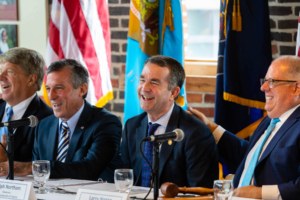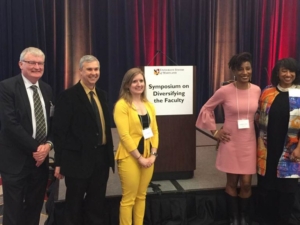Although diversity has been a priority at Chesapeake Bay institutions for many years, the Chesapeake Bay Program (CBP) recently committed to a Diversity Directive to further promote increased diversity throughout the CBP community.
In 2016, the Alliance for the Chesapeake Bay released the results of its first-ever diversity profile after surveying approximately 750 people who work with or for the Chesapeake Bay Program (CBP) partnership. That survey revealed that “84% of respondents identified as white, while just 13% of respondents identified as non-white” (source), while 35% of people in the watershed identify as non-white.
While these numbers only reflect direct interaction with CBP and do not necessarily represent the larger Bay research, management, or stewardship communities, they are notably much different than diversity within the general population of 18 million residents of the Bay watershed.
To help address this concern, the Chesapeake Executive Council committed to achieving new diversity goals by 2025. These include increasing the percentage of people of color engaged in the Chesapeake Bay Program (CBP) to 25% and the percentage of people of color in leadership positions to 15%.

Chesapeake Bay Commission Chair, Senator Frank Wagner; Delaware Governor Carney; Virginia Governor Northam; and Maryland Governor Hogan at the 2018 Chesapeake Executive Council meeting in Baltimore, Maryland. (Image by Will Parson/Chesapeake Bay Program)
In light of this, we reached out to CRC members to gain a sense of how academia is working to increase diversity among students and faculty and highlight what practices its members see as most effective.
Students
Research Experience for Undergraduates (REU) programs sponsored by the National Science Foundation (NSF) provide a unique opportunity for students to conduct research outside their home institution for a summer. NSF encourages host institutions to choose students who wouldn’t otherwise be able to conduct research at their home schools, focusing on students from underrepresented backgrounds.

Source: UMBC STRIDE Program
One effective way to recruit students from diverse backgrounds to apply to REU programs is to meet them in person. Fredrika Moser, Director of Maryland Sea Grant, says she and her staff attend meetings where they can get in front of students and faculty they’re interested in recruiting. Maryland Sea Grant administers an REU program that provides an opportunity for students to conduct research at the University of Maryland Center for Environmental Science (UMCES) Horn Point Laboratory and Chesapeake Biological Laboratory. Moser notes that it’s crucial to build trust and relationships with faculty from other universities so that they can recommend their REU program to their students. Rodger Harvey, professor of Ocean, Earth, and Atmospheric Sciences (OEAS) at Old Dominion University (ODU), agrees. He recommends focusing on attending undergraduate-focused conferences, tabling, and providing flyers. He also recommends following up with students after meeting them and encouraging them to apply.
Once students know about the REU program, it’s essential that the application does not deter them from applying. “You want to make the application more accessible to a wider variety of people,” explains Mike Allen, Associate Director for Research & Administration at Maryland Sea Grant. They have information online on how to write the application and personal statement, how to ask for letters of recommendation, and what makes a good letter. They want to make the application be the lowest possible barrier to entry, so as not to discourage students unfamiliar with the application process from even applying. They also found that having an online application portal makes it easier to find all of these resources in one place.
While evaluating applicants, many institutions also evaluate how helpful the REU will be for the student’s future. “We don’t necessarily take the top scoring applicants who apply if they’ve already done an REU in the past,” explains Harvey. “We try to spend time up front looking for students for whom an REU opportunity would have a big impact on their future.” They look for students who come from universities that don’t have strong research programs, especially community colleges and non-R1 institutions. Within this context, however, the CRC Board and the CRC Executive Director, Bill Ball, see a need to follow-up with students who have had successful research experiences and provide continued encouragement and mentoring toward advanced careers, and this is where CRC’s C-StREAM Program comes in. Working in synergy with existing REU and agency internship programs, the C-StREAM Fellowship Program aims to recruit promising students from typically under-represented groups and provide longer-term mentoring that includes first summer experiences as well as continuing advisement in the academic year and in following summers, including post-baccalaureate where appropriate. With this goal in mind, the C-StREAM Program supports Fellows within existing REU and agency-intern cohorts and with the specific intent of of linking in advisors at their home institutions and, for successful students, following-up with subsequent mentoring and support. The hope is to encourage students throughout their education and into longer-term employment as environmental leaders..
Once the students enter the REU program, host institutions make every effort to include and develop all students, building their abilities as a researcher and a professional. “We want to make sure the students who come here are fully successful and are included in the institution, cohort, and that they have the support and resources to grow,” explains Moser. This means that students are trained in professional development during their programs, including how to give a talk, complete applications for fellowships, and writing strong applications. “It’s extremely important to teach the culture of science, academia, and research to these students,” Moser continues. “If you want people to fit in a club, you need to give them the rulebook.” Troy Hartley, Director of Virginia Sea Grant, noted that they’ve had success in their professional development training: “through our training, we emphasize skills in teamwork, team science, innovation, and integrating different types of knowledge.” Harvey added that at ODU, they try to promote their REU students’ research at conferences, follow up with them after their REUs end, and help thems apply to graduate school. All of this support is crucial to helping students who might not be trained in the nuances of academia achieve their graduate school goals.
Faculty
In order to encourage more students from underrepresented backgrounds to choose science careers, it’s crucial that they see people who they can identify with as their faculty and leaders. With so few minorities historically receiving PhDs in the sciences, it’s very important to hire faculty that can bring fresh perspectives to their departments.

STRIDE Symposium at UMBC
Similarly to recruiting students, making personal connections is an important way to recruit faculty from underrepresented backgrounds. “Faculty and members of search committees need to figure out where possible candidates are and encourage those individuals to apply,” explains Russell Hill, Director and Professor at the Institute of Marine and Environmental Technology (IMET) at UMCES. “If you don’t start off with a strong, diverse applicant pool, you won’t get outcomes where minorities can emerge as top candidates.”
Behind the scenes, it’s crucial that search committees are focused on recruiting excellence of all forms. At University of Maryland Baltimore County (UMBC), prior to the authorization of a search, all search committees are required to submit a Diversity Hiring Recruitment Plan. These plans have three main components: 1) a rationale for search committee composition and roles, 2) an active recruitment strategy, and 3) a draft of the job ad. The committees are deliberately chosen with professors from different ranks and backgrounds so as to provide a variety of perspectives. The active recruitment strategy must be robust and include how the committee will identify new places to advertise the position, beyond placing advertisements in more traditional venues like journals. These might include direct contact with universities known to produce diverse graduates and engaging direct recruitment at such conferences as the Southern Regional Education Board (SREB), the Society for the Advancement of Chicanos and Native Americans in Sciences (SACNAS). Additionally, faculty are expected to engage in faculty field networking at their own disciplinary conferences and encourage scholars to apply for positions. Job advertisements must also have inclusive and welcoming language and require applicants to submit a statement on their commitment to inclusive excellence in higher education, which could include how the applicant has mentored students from underrepresented groups, lived experiences, teaching methods, specific research, etc. To help search committees conduct inclusive searches, in 2015 UMBC formed the Committee on Strategies and Tactics to Recruit and Improve Diversity for Excellence (STRIDE), a group of highly-respected faculty that facilitate focused conversations with their peers on the best practices for diverse and inclusion search processes. These STRIDE peer education consultations, with search committees, help produce effective diversity hiring recruitment plans, inclusive job ads, application evaluation criteria, transparent application review processes, and inclusive interview protocols. “We believe our search committees should be just as rigorous as our research,” explains Autumn Reed, Assistant Vice Provost for Faculty Affairs at UMBC and Director of STRIDE.
In order to keep diversity a priority in faculty recruiting, hosting conferences and talks to understand fresh perspectives is a great way to draw more attention to the issue. For example, University System of Maryland (USM) hosted a symposium on diversifying the faculty this past April, hosting members of all 12 universities. The symposium offered a place for members to share best practices and charge all of the institutions with applying lessons learned to their own hiring processes. “It’s important to remember there isn’t a one-size-fits-all approach,” explains Reed. “Each field and department need to reflect on their situation, where their diversity could be, and where they could do better. It’s about getting away from that ‘check the box’ mentality, considering the entire talent pool, and finding real excellence.”
Another similarity to recruiting students is to make applications accessible. “This is the first experience the applicant might have with the institution, and first impressions are crucial,” explains Reed. She recommends drafting a job ad that includes details about the department, so the applicant can get a sense of what it’s really like to work there. The goal is to make the applicant feel like this is a place they’d want to work. When drafting the ad for a faculty position, it’s important to understand how the criteria for the position could be interpreted by the applicant. “When a job description is too specific, the applicant might think the school already has a candidate in mind,” explains Reed. When writing the specifications for the job, she recommends being broad but deliberate. “White males tend to be more confident when they look at a list of criteria in an application,” explains Hill, “whereas women and minority candidates look at that long list and if they don’t think they fit even one or two of the criteria, they may choose not to apply.” Therefore, keep the most essential details in the application, and advertise it across a wide range of journals and platforms in order to attract faculty from a variety of backgrounds.
Students and faculty from underrepresented backgrounds bring a great deal of value to their universities. “It’s becoming clear in industry that diverse organizations make better decisions and can even be more profitable,” explains Hill. “A diverse faculty and student body improve the quality of the science coming from our institutions.” Reed agrees, stating, “how can we be innovative and cutting edge if we’re not diverse?” In addition, having diverse perspectives participating in Chesapeake Bay research is crucial to its restoration. “We want our science to represent the perspectives of all Bay residents,” explains Harvey. “We want everyone to have a seat at the table, translating our solutions and research to other communities. Because at the end of the day, every community is affected by these issues.”
